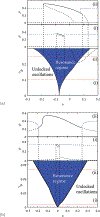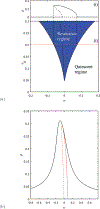Frequency locking in auditory hair cells: Distinguishing between additive and parametric forcing
- PMID: 33859450
- PMCID: PMC8046175
- DOI: 10.1209/0295-5075/116/28002
Frequency locking in auditory hair cells: Distinguishing between additive and parametric forcing
Abstract
- The auditory system displays remarkable sensitivity and frequency discrimination, attributes shown to rely on an amplification process that involves a mechanical as well as a biochemical response. Models that display proximity to an oscillatory onset (also known as Hopf bifurcation) exhibit a resonant response to distinct frequencies of incoming sound, and can explain many features of the amplification phenomenology. To understand the dynamics of this resonance, frequency locking is examined in a system near the Hopf bifurcation and subject to two types of driving forces: additive and parametric. Derivation of a universal amplitude equation that contains both forcing terms enables a study of their relative impact on the hair cell response. In the parametric case, although the resonant solutions are 1 : 1 frequency locked, they show the coexistence of solutions obeying a phase shift of π, a feature typical of the 2 : 1 resonance. Different characteristics are predicted for the transition from unlocked to locked solutions, leading to smooth or abrupt dynamics in response to different types of forcing. The theoretical framework provides a more realistic model of the auditory system, which incorporates a direct modulation of the internal control parameter by an applied drive. The results presented here can be generalized to many other media, including Faraday waves, chemical reactions, and elastically driven cardiomyocytes, which are known to exhibit resonant behavior.
Keywords: Biological and medical physics; Elasticity theory; Nonlinear dynamics and chaos; Sensory systems; auditory; olfactation; tactile; taste; visual.
Figures


References
Grants and funding
LinkOut - more resources
Full Text Sources
Research Materials
Miscellaneous
